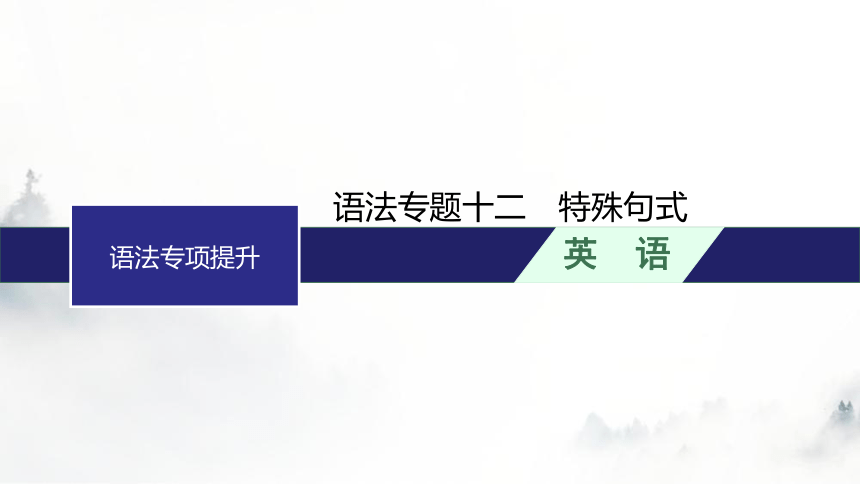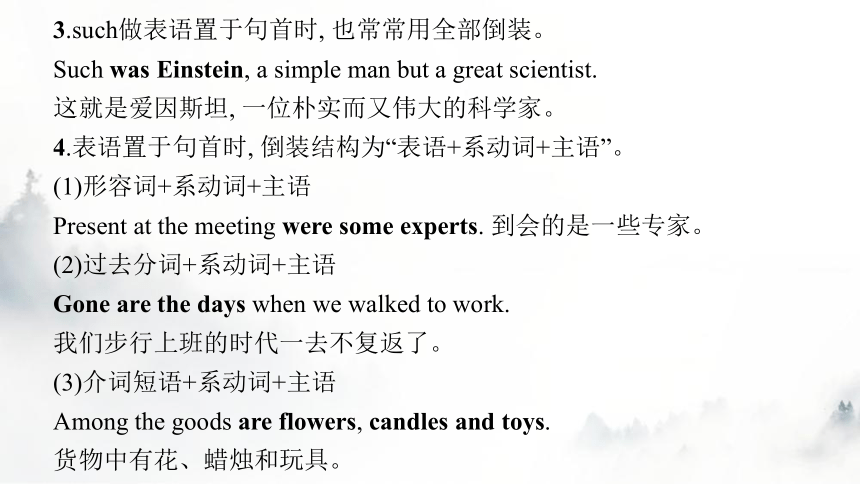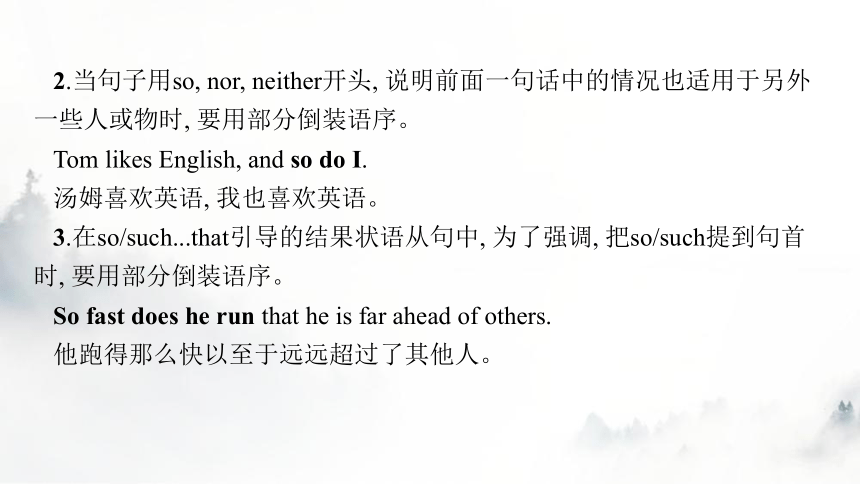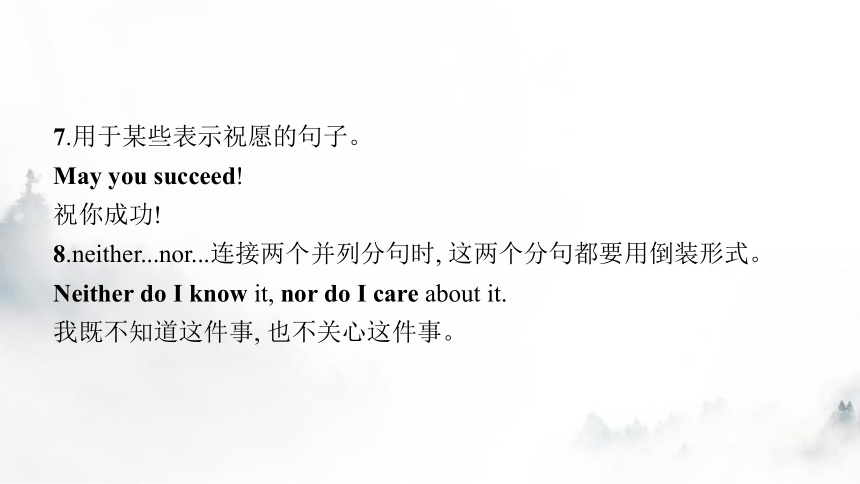2024届人教版高考英语二轮复习语法专题12特殊句式课件(共36张PPT)
文档属性
| 名称 | 2024届人教版高考英语二轮复习语法专题12特殊句式课件(共36张PPT) |  | |
| 格式 | ppt | ||
| 文件大小 | 723.0KB | ||
| 资源类型 | 教案 | ||
| 版本资源 | 人教版(2019) | ||
| 科目 | 英语 | ||
| 更新时间 | 2024-02-04 11:02:39 | ||
图片预览












文档简介
(共36张PPT)
语法专项提升
语法专题十二 特殊句式
英 语
内容索引
核心考点 分层突破
专项训练 巩固提升
核心考点 分层突破
高考链接
1.(2018·北京, 单项填空)In any unsafe situation, simply (press) the button and a highly-trained agent will get you the help you need.
press
句意: 在任何不安全的情况下, 只需摁一下这个按钮, 一位训练有素的代理人就会来帮你。本题是 “祈使句+and+简单句” 结构, 故填动词原形。
2.(2018·天津, 单项填空)It was only when the car pulled up in front of our house we saw Lily in the passenger seat.
that
句意: 只有当汽车停在我们房前时, 我们才看到在乘客座位上的莉莉。强调句型结构为: It is/ was+被强调部分(通常是主语、宾语或状语)+that/ who(当强调主语且主语指人时)+其他部分。
考点归纳
倒装
考点一 完全倒装
1.表示时间、地点、方位和动作转移的副词, 如当there, here, now, then, up, down, out, in, away位于句首, 句子谓语是go, come, run等不及物动词时, 可将谓语全部置于主语之前。但主语是人称代词时, 不倒装。
Up went the arrow into the air.
箭射上了天。
2.当句首状语为表示地点的介词短语时, 也常常用全部倒装。
Under the tree stands a little boy.
树下站着个小男孩。
3.such做表语置于句首时, 也常常用全部倒装。
Such was Einstein, a simple man but a great scientist.
这就是爱因斯坦, 一位朴实而又伟大的科学家。
4.表语置于句首时, 倒装结构为“表语+系动词+主语”。
(1)形容词+系动词+主语
Present at the meeting were some experts. 到会的是一些专家。
(2)过去分词+系动词+主语
Gone are the days when we walked to work.
我们步行上班的时代一去不复返了。
(3)介词短语+系动词+主语
Among the goods are flowers, candles and toys.
货物中有花、蜡烛和玩具。
考点二 部分倒装
1.句子以never, seldom, rarely, little, hardly, scarcely等表示否定意义的副词以及by no means, not until, not only, on no condition, in no case等表示否定意义的短语开头, 要用部分倒装语序。
Never have I heard American music played better in a foreign land.
我在外国从来没有听到过演奏得这么好的美国音乐。
Not only do the nurses want a pay increase, they also want to reduce working hours.
护士们不仅想要增加报酬, 而且还想减少工作时间。
2.当句子用so, nor, neither开头, 说明前面一句话中的情况也适用于另外一些人或物时, 要用部分倒装语序。
Tom likes English, and so do I.
汤姆喜欢英语, 我也喜欢英语。
3.在so/such...that引导的结果状语从句中, 为了强调, 把so/such提到句首时, 要用部分倒装语序。
So fast does he run that he is far ahead of others.
他跑得那么快以至于远远超过了其他人。
4.as/though引导让步状语从句时句子要用倒装语序。在as/though引导的让步状语从句中, 做表语的单数可数名词前不用加任何冠词。
Child as he is, he knows a lot.
尽管他是个孩子, 但他懂得很多。
5.在省略if的虚拟条件句中, were, had或should要提到句首构成倒装。
Had you come a few minutes earlier, you would have seen him.
如果你早来几分钟, 你就能看见他了。
6.当only所修饰的副词、介词短语或状语从句位于句首时, 采用部分倒装形式。要注意“only+主语”用在句首时不倒装。
Only when John walked into the classroom did he realise that he had left his book at home.
直到约翰走进教室, 他才意识到自己把书落在家里了。
Only you can help me. 只有你能帮助我。
7.用于某些表示祝愿的句子。
May you succeed!
祝你成功!
8.neither...nor...连接两个并列分句时, 这两个分句都要用倒装形式。
Neither do I know it, nor do I care about it.
我既不知道这件事, 也不关心这件事。
省略
考点一 不定式中的省略
1.单独使用不定式符号to代替不定式后被省略的动词, 常用在be afraid, expect, forget, hope, intend, like, love, mean, prefer, refuse, try, want, wish等词后; 或放在表情绪的词后, 代替被省略的动词, 常见词有glad, happy, pleased等; 但是, 如果不定式中含有be, have, have been, 则不应省略。
I asked him to see the film, but he didn’t want to.
我叫他去看电影, 但他不想去。
He is not a lawyer now, but he used to be.
他现在已不是律师了, 但他曾经是。
Your work hasn’t been handed in, but it ought to have been.
你的作业还没交, 但早该上交了。
2.感官动词或使役动词(feel, notice, see, hear, let, make, have等)后接不定式做宾语补足语时常省略to。
I heard my father sing in the kitchen.
我听见爸爸在厨房里唱歌。
3.在由and或or连接的并列不定式结构中常省略后面的to。
I want to finish my homework and go home.
我想完成作业然后回家。
4.在do nothing but, can’t help but, why not, would rather...than..., had better等句型中省略to。
The little boy could do nothing but cry.
小男孩只能哭, 别无他法。
考点二 状语从句中的省略
1.在由when, while, if, as if, although/though, as, until, once, whether, where等引导的状语从句中, 当状语从句的主语和主句的主语一致且从句谓语含有be时, 可省略状语从句的主语和be。
When (he was) young, he helped his parents do a lot of housework.
他小的时候帮父母干了很多家务活。
2.当从句的主语是it, 谓语动词是be动词时, 可以把it和be一起省略。此时构成“连词+形容词”的结构。
Though (it was) cold, he still wore a shirt.
尽管天冷, 但他仍然穿着一件衬衣。
3.在if so/not省略句式中, 用so/not代替上文的内容。
Get up early tomorrow. If not(=If you don’t get up early tomorrow), you will miss the early bus.
明天早点起床, 不然的话, 你就会错过早班车。
强调句
考点一 强调句的基本构成
强调句的基本构成为: It is/was+被强调部分+who/that+其他成分。被强调部分指人时, 可用who或that; 被强调部分指物时, 用that。如:
It was John who/that wore his best suit to the dance last night.
是约翰昨晚穿着他最好的一套西装去参加舞会。
It was his best suit that John wore to the dance last night.
约翰昨晚是穿着他最好的一套西装去参加舞会的。
考点二 强调句的疑问句形式
强调句的一般疑问句形式为 “Is/Was it+被强调部分+that/who+其他成分 ”; 特殊疑问句形式为“特殊疑问词+is/was it+that/who+其他成分 ”。
Was it in high school that you began playing basketball
你是不是在高中的时候开始打篮球的
Where was it that you put your mobile phone after coming back
你回来之后把手机放在什么地方了
考点三 not...until...结构在强调句中
not...until...结构中的状语成分在强调句型中被强调时, not与until要放在一起。
Bach died in 1750, but it was not until the early 19th century that his musical gift was fully recognised.
巴赫于1750年去世, 但直到19世纪早期他的音乐才华才受到普遍认可。
It was not until he removed his sunglasses that I recognised him.
直到他把太阳镜摘下来我才将他认了出来。
附加疑问句
考点一 陈述部分含有宾语从句的附加疑问句
1.当陈述部分带有宾语从句时, 附加疑问部分的主语与谓语常和主句保持一致。
He said that they would come to my birthday party, didn’t he
他说他们要来参加我的生日聚会, 是吗
2.当陈述部分主句的谓语动词是think, believe, suppose, guess, expect, imagine, 且主句主语为第一人称时, 附加疑问部分的主语和谓语与宾语从句的主语和谓语保持一致; 当陈述部分主句的主语为第二、三人称时, 后面的疑问部分的主语和谓语与主句的主语和谓语保持一致。
They don’t believe he will succeed, do they
他们不相信他会成功, 是吗
考点二 陈述部分含有否定词的附加疑问句
当陈述部分带有seldom, hardly, scarcely, never, few, little, nothing, nobody等否定词时, 附加疑问部分用肯定形式。但带有表示否定意义的前缀构成的词时, 其附加疑问部分用否定形式。
He could hardly speak English, could he
他几乎不会说英语, 是吗
He dislikes playing the piano, doesn’t he
他不喜欢弹钢琴, 是吗
祈使句
考点一 祈使句+and+简单句
“祈使句+and+简单句”表示“如果……就……”
Contribute a bit love, and you will make the world a nicer place to live in.
只要你能献出一点爱, 你就会使这个世界成为一个更好的居住家园。
考点二 祈使句+or+简单句
“祈使句+or+简单句”表示“……否则……”
Listen to the teacher carefully in class, or you can’t catch what he is saying.
上课时仔细听老师讲, 否则你听不懂他在说什么。
注意有时名词短语可以看作祈使句。
A few more minutes and I will finish the work.
再给我几分钟我就会完成这项工作。
感叹句
考点一 What a(n)+形容词+单数名词+主语+谓语!
What an interesting story it is! 多么有趣的故事啊!
What a happy day it is! 多么快乐的一天啊!
考点二 What+形容词+复数名词+主语+谓语!
What beautiful butterflies they are! 多么漂亮的蝴蝶啊!
考点三 How+形容词+a(n)+单数名词+主语+谓语!
How tall a boy he is! 这个男孩真高啊!
考点四 How+形容词/副词+主语+谓语!
How well she plays! 她演奏得多好啊!
专项训练 巩固提升
Ⅰ.单句语法填空
1.If your kids are looking for something a little trickier, why let them try using magnets to make their own compass(指南针)
2.It was your timely appearance helped me out of the embarrassing situation.
not
Why not do.... 为固定句型, 意为 “何不…….呢 ”, 常用来给别人提建议。
that
该句考查It was...that...强调句型。
3.It was when I got back to my apartment I first came across my new neighbours.
4.It could be anything—gardening, cooking, music, sports—but whatever it is,
(make) sure it’s a relief from daily stress rather than another thing to worry about.
that
句意: 就在我回到公寓的时候, 我第一次遇见了我的新邻居。强调句型的构成为: It is/was+被强调部分+that/who+句子其他部分。本句中被强调的部分是时间状语从句when I got back to my apartment, 故用that。
make
前面whatever it is引导让步状语从句, 此处是一个完整句子, 因此只能用动词原形放句首, 构成祈使句。
5.You are waiting at a wrong place. It is at the hotel the coach picks up tourists.
6.Always (keep) in mind that your main task is to get this company running smoothly.
that
句意: 你等错地方了。长途汽车在宾馆接游客。强调句型的构成为: It is/was+被强调部分+that/who+句子其他部分。本句中at the hotel是被强调部分, 故填that。
keep
句意: 始终记住你的主要任务是使这个公司运转顺利。本句为祈使句, 谓语动词用动词原形。
7.It’s not doing the things we like, but liking the things we have to do
makes life happy.
8.Overcome it we will be able to achieve our goals.
that
句意: 不是做我们喜欢的事情而是喜欢我们要做的事情才使得人生幸福快乐。此处为强调句, 强调的是句子的主语, 故填that。
and
此处为 “祈使句+and+陈述句”, 故用连词 and。
9.Don’t forget to put the tools back where they were after you have finished your work, you
will
句意: 干完活不要忘了把工具放回原处, 好吗 否定祈使句的附加疑问句用肯定形式, 故填will。
10.It was not until near the end of the letter she mentioned her own plan.
that
强调句的基本结构: It is/was+被强调部分+that/who+句子的其他部分。句意: 直到将近这封信的末尾她才提到自己的计划。
11.The teacher stressed that the students should not leave out any important details while (retell) the story.
retelling
本句是一个省略句, 由于主句的主语和从句的主语一致, 而且从句谓语中含有be动词, 所以可省略从句的主语和be动词, 故填retelling。
12.It was only when I watched the film a second time I had a better understanding of what it was talking about.
that
句意: 我再次观看这部电影时, 我才更好地理解了它讨论的是什么。题干中强调的是only when I watched the film a second time。强调句型结构: It is/was+被强调部分+that/who+句子的其他部分。
13. (take) a deep breath and you will immediately feel the spring in the air.
Take
句意: 深呼吸, 你就会立即感觉到春天的气息。此处是句型: 祈使句+and+陈述句。
14.At the top of the hill (lie) an old cottage which has a wonderful view of the whole city.
lies
本句为表示地点的介词短语置于句首, 所以句子要用完全倒装形式。主语是an old cottage, 句子是一般现在时, 故填lies。
Ⅱ.用括号内单词的正确顺序填空
1.Under no circumstances (children, should, be) allowed to drive.
2.Only after months of planning (ready, they, were) for the conference.
should children be
表示否定意义的词组开头, 要用部分倒装语序, 故应填should children be。
were they ready
only所修饰的介词短语位于句首, 应采用部分倒装形式, 故应填were they ready。
3.No sooner (I, had, left) than I heard them laughing.
4.Now (time, the, was) to escape and she jumped from the window.
had I left
no sooner放在句首, 要用部分倒装语序, 故应填had I left。
was the time
表示时间的副词now位于句首, 要用完全倒装语序, 故此处应填was the time。
5.Many a time (plan, she, did) to divorce her husband, but she never did.
did she plan
many a time 在句中充当了状语, 且提前至句首, 故引起部分倒装。
6.Only when (Jane, has, arrived) can we start the party.
Jane has arrived
“only+状语从句”位于句首, 其中状语从句应用陈述语序, 故应填Jane has arrived。
7. (Max, It, was) who borrowed the money.
8.Never (seen, I, have) so much snow in November!
It was Max
该句为强调句, 其基本构成为: It is/was+被强调部分+who/that+句子的其他成分。故应填It was Max。
have I seen
表示否定意义的副词never开头, 故要用部分倒装语序。
9.Not until (saw, I) John with my own eyes did I really believe he was safe.
I saw
not until引导的条件状语从句, 置于句首, 主句要用部分倒装语序, 从句应用陈述语序, 故应填I saw。
语法专项提升
语法专题十二 特殊句式
英 语
内容索引
核心考点 分层突破
专项训练 巩固提升
核心考点 分层突破
高考链接
1.(2018·北京, 单项填空)In any unsafe situation, simply (press) the button and a highly-trained agent will get you the help you need.
press
句意: 在任何不安全的情况下, 只需摁一下这个按钮, 一位训练有素的代理人就会来帮你。本题是 “祈使句+and+简单句” 结构, 故填动词原形。
2.(2018·天津, 单项填空)It was only when the car pulled up in front of our house we saw Lily in the passenger seat.
that
句意: 只有当汽车停在我们房前时, 我们才看到在乘客座位上的莉莉。强调句型结构为: It is/ was+被强调部分(通常是主语、宾语或状语)+that/ who(当强调主语且主语指人时)+其他部分。
考点归纳
倒装
考点一 完全倒装
1.表示时间、地点、方位和动作转移的副词, 如当there, here, now, then, up, down, out, in, away位于句首, 句子谓语是go, come, run等不及物动词时, 可将谓语全部置于主语之前。但主语是人称代词时, 不倒装。
Up went the arrow into the air.
箭射上了天。
2.当句首状语为表示地点的介词短语时, 也常常用全部倒装。
Under the tree stands a little boy.
树下站着个小男孩。
3.such做表语置于句首时, 也常常用全部倒装。
Such was Einstein, a simple man but a great scientist.
这就是爱因斯坦, 一位朴实而又伟大的科学家。
4.表语置于句首时, 倒装结构为“表语+系动词+主语”。
(1)形容词+系动词+主语
Present at the meeting were some experts. 到会的是一些专家。
(2)过去分词+系动词+主语
Gone are the days when we walked to work.
我们步行上班的时代一去不复返了。
(3)介词短语+系动词+主语
Among the goods are flowers, candles and toys.
货物中有花、蜡烛和玩具。
考点二 部分倒装
1.句子以never, seldom, rarely, little, hardly, scarcely等表示否定意义的副词以及by no means, not until, not only, on no condition, in no case等表示否定意义的短语开头, 要用部分倒装语序。
Never have I heard American music played better in a foreign land.
我在外国从来没有听到过演奏得这么好的美国音乐。
Not only do the nurses want a pay increase, they also want to reduce working hours.
护士们不仅想要增加报酬, 而且还想减少工作时间。
2.当句子用so, nor, neither开头, 说明前面一句话中的情况也适用于另外一些人或物时, 要用部分倒装语序。
Tom likes English, and so do I.
汤姆喜欢英语, 我也喜欢英语。
3.在so/such...that引导的结果状语从句中, 为了强调, 把so/such提到句首时, 要用部分倒装语序。
So fast does he run that he is far ahead of others.
他跑得那么快以至于远远超过了其他人。
4.as/though引导让步状语从句时句子要用倒装语序。在as/though引导的让步状语从句中, 做表语的单数可数名词前不用加任何冠词。
Child as he is, he knows a lot.
尽管他是个孩子, 但他懂得很多。
5.在省略if的虚拟条件句中, were, had或should要提到句首构成倒装。
Had you come a few minutes earlier, you would have seen him.
如果你早来几分钟, 你就能看见他了。
6.当only所修饰的副词、介词短语或状语从句位于句首时, 采用部分倒装形式。要注意“only+主语”用在句首时不倒装。
Only when John walked into the classroom did he realise that he had left his book at home.
直到约翰走进教室, 他才意识到自己把书落在家里了。
Only you can help me. 只有你能帮助我。
7.用于某些表示祝愿的句子。
May you succeed!
祝你成功!
8.neither...nor...连接两个并列分句时, 这两个分句都要用倒装形式。
Neither do I know it, nor do I care about it.
我既不知道这件事, 也不关心这件事。
省略
考点一 不定式中的省略
1.单独使用不定式符号to代替不定式后被省略的动词, 常用在be afraid, expect, forget, hope, intend, like, love, mean, prefer, refuse, try, want, wish等词后; 或放在表情绪的词后, 代替被省略的动词, 常见词有glad, happy, pleased等; 但是, 如果不定式中含有be, have, have been, 则不应省略。
I asked him to see the film, but he didn’t want to.
我叫他去看电影, 但他不想去。
He is not a lawyer now, but he used to be.
他现在已不是律师了, 但他曾经是。
Your work hasn’t been handed in, but it ought to have been.
你的作业还没交, 但早该上交了。
2.感官动词或使役动词(feel, notice, see, hear, let, make, have等)后接不定式做宾语补足语时常省略to。
I heard my father sing in the kitchen.
我听见爸爸在厨房里唱歌。
3.在由and或or连接的并列不定式结构中常省略后面的to。
I want to finish my homework and go home.
我想完成作业然后回家。
4.在do nothing but, can’t help but, why not, would rather...than..., had better等句型中省略to。
The little boy could do nothing but cry.
小男孩只能哭, 别无他法。
考点二 状语从句中的省略
1.在由when, while, if, as if, although/though, as, until, once, whether, where等引导的状语从句中, 当状语从句的主语和主句的主语一致且从句谓语含有be时, 可省略状语从句的主语和be。
When (he was) young, he helped his parents do a lot of housework.
他小的时候帮父母干了很多家务活。
2.当从句的主语是it, 谓语动词是be动词时, 可以把it和be一起省略。此时构成“连词+形容词”的结构。
Though (it was) cold, he still wore a shirt.
尽管天冷, 但他仍然穿着一件衬衣。
3.在if so/not省略句式中, 用so/not代替上文的内容。
Get up early tomorrow. If not(=If you don’t get up early tomorrow), you will miss the early bus.
明天早点起床, 不然的话, 你就会错过早班车。
强调句
考点一 强调句的基本构成
强调句的基本构成为: It is/was+被强调部分+who/that+其他成分。被强调部分指人时, 可用who或that; 被强调部分指物时, 用that。如:
It was John who/that wore his best suit to the dance last night.
是约翰昨晚穿着他最好的一套西装去参加舞会。
It was his best suit that John wore to the dance last night.
约翰昨晚是穿着他最好的一套西装去参加舞会的。
考点二 强调句的疑问句形式
强调句的一般疑问句形式为 “Is/Was it+被强调部分+that/who+其他成分 ”; 特殊疑问句形式为“特殊疑问词+is/was it+that/who+其他成分 ”。
Was it in high school that you began playing basketball
你是不是在高中的时候开始打篮球的
Where was it that you put your mobile phone after coming back
你回来之后把手机放在什么地方了
考点三 not...until...结构在强调句中
not...until...结构中的状语成分在强调句型中被强调时, not与until要放在一起。
Bach died in 1750, but it was not until the early 19th century that his musical gift was fully recognised.
巴赫于1750年去世, 但直到19世纪早期他的音乐才华才受到普遍认可。
It was not until he removed his sunglasses that I recognised him.
直到他把太阳镜摘下来我才将他认了出来。
附加疑问句
考点一 陈述部分含有宾语从句的附加疑问句
1.当陈述部分带有宾语从句时, 附加疑问部分的主语与谓语常和主句保持一致。
He said that they would come to my birthday party, didn’t he
他说他们要来参加我的生日聚会, 是吗
2.当陈述部分主句的谓语动词是think, believe, suppose, guess, expect, imagine, 且主句主语为第一人称时, 附加疑问部分的主语和谓语与宾语从句的主语和谓语保持一致; 当陈述部分主句的主语为第二、三人称时, 后面的疑问部分的主语和谓语与主句的主语和谓语保持一致。
They don’t believe he will succeed, do they
他们不相信他会成功, 是吗
考点二 陈述部分含有否定词的附加疑问句
当陈述部分带有seldom, hardly, scarcely, never, few, little, nothing, nobody等否定词时, 附加疑问部分用肯定形式。但带有表示否定意义的前缀构成的词时, 其附加疑问部分用否定形式。
He could hardly speak English, could he
他几乎不会说英语, 是吗
He dislikes playing the piano, doesn’t he
他不喜欢弹钢琴, 是吗
祈使句
考点一 祈使句+and+简单句
“祈使句+and+简单句”表示“如果……就……”
Contribute a bit love, and you will make the world a nicer place to live in.
只要你能献出一点爱, 你就会使这个世界成为一个更好的居住家园。
考点二 祈使句+or+简单句
“祈使句+or+简单句”表示“……否则……”
Listen to the teacher carefully in class, or you can’t catch what he is saying.
上课时仔细听老师讲, 否则你听不懂他在说什么。
注意有时名词短语可以看作祈使句。
A few more minutes and I will finish the work.
再给我几分钟我就会完成这项工作。
感叹句
考点一 What a(n)+形容词+单数名词+主语+谓语!
What an interesting story it is! 多么有趣的故事啊!
What a happy day it is! 多么快乐的一天啊!
考点二 What+形容词+复数名词+主语+谓语!
What beautiful butterflies they are! 多么漂亮的蝴蝶啊!
考点三 How+形容词+a(n)+单数名词+主语+谓语!
How tall a boy he is! 这个男孩真高啊!
考点四 How+形容词/副词+主语+谓语!
How well she plays! 她演奏得多好啊!
专项训练 巩固提升
Ⅰ.单句语法填空
1.If your kids are looking for something a little trickier, why let them try using magnets to make their own compass(指南针)
2.It was your timely appearance helped me out of the embarrassing situation.
not
Why not do.... 为固定句型, 意为 “何不…….呢 ”, 常用来给别人提建议。
that
该句考查It was...that...强调句型。
3.It was when I got back to my apartment I first came across my new neighbours.
4.It could be anything—gardening, cooking, music, sports—but whatever it is,
(make) sure it’s a relief from daily stress rather than another thing to worry about.
that
句意: 就在我回到公寓的时候, 我第一次遇见了我的新邻居。强调句型的构成为: It is/was+被强调部分+that/who+句子其他部分。本句中被强调的部分是时间状语从句when I got back to my apartment, 故用that。
make
前面whatever it is引导让步状语从句, 此处是一个完整句子, 因此只能用动词原形放句首, 构成祈使句。
5.You are waiting at a wrong place. It is at the hotel the coach picks up tourists.
6.Always (keep) in mind that your main task is to get this company running smoothly.
that
句意: 你等错地方了。长途汽车在宾馆接游客。强调句型的构成为: It is/was+被强调部分+that/who+句子其他部分。本句中at the hotel是被强调部分, 故填that。
keep
句意: 始终记住你的主要任务是使这个公司运转顺利。本句为祈使句, 谓语动词用动词原形。
7.It’s not doing the things we like, but liking the things we have to do
makes life happy.
8.Overcome it we will be able to achieve our goals.
that
句意: 不是做我们喜欢的事情而是喜欢我们要做的事情才使得人生幸福快乐。此处为强调句, 强调的是句子的主语, 故填that。
and
此处为 “祈使句+and+陈述句”, 故用连词 and。
9.Don’t forget to put the tools back where they were after you have finished your work, you
will
句意: 干完活不要忘了把工具放回原处, 好吗 否定祈使句的附加疑问句用肯定形式, 故填will。
10.It was not until near the end of the letter she mentioned her own plan.
that
强调句的基本结构: It is/was+被强调部分+that/who+句子的其他部分。句意: 直到将近这封信的末尾她才提到自己的计划。
11.The teacher stressed that the students should not leave out any important details while (retell) the story.
retelling
本句是一个省略句, 由于主句的主语和从句的主语一致, 而且从句谓语中含有be动词, 所以可省略从句的主语和be动词, 故填retelling。
12.It was only when I watched the film a second time I had a better understanding of what it was talking about.
that
句意: 我再次观看这部电影时, 我才更好地理解了它讨论的是什么。题干中强调的是only when I watched the film a second time。强调句型结构: It is/was+被强调部分+that/who+句子的其他部分。
13. (take) a deep breath and you will immediately feel the spring in the air.
Take
句意: 深呼吸, 你就会立即感觉到春天的气息。此处是句型: 祈使句+and+陈述句。
14.At the top of the hill (lie) an old cottage which has a wonderful view of the whole city.
lies
本句为表示地点的介词短语置于句首, 所以句子要用完全倒装形式。主语是an old cottage, 句子是一般现在时, 故填lies。
Ⅱ.用括号内单词的正确顺序填空
1.Under no circumstances (children, should, be) allowed to drive.
2.Only after months of planning (ready, they, were) for the conference.
should children be
表示否定意义的词组开头, 要用部分倒装语序, 故应填should children be。
were they ready
only所修饰的介词短语位于句首, 应采用部分倒装形式, 故应填were they ready。
3.No sooner (I, had, left) than I heard them laughing.
4.Now (time, the, was) to escape and she jumped from the window.
had I left
no sooner放在句首, 要用部分倒装语序, 故应填had I left。
was the time
表示时间的副词now位于句首, 要用完全倒装语序, 故此处应填was the time。
5.Many a time (plan, she, did) to divorce her husband, but she never did.
did she plan
many a time 在句中充当了状语, 且提前至句首, 故引起部分倒装。
6.Only when (Jane, has, arrived) can we start the party.
Jane has arrived
“only+状语从句”位于句首, 其中状语从句应用陈述语序, 故应填Jane has arrived。
7. (Max, It, was) who borrowed the money.
8.Never (seen, I, have) so much snow in November!
It was Max
该句为强调句, 其基本构成为: It is/was+被强调部分+who/that+句子的其他成分。故应填It was Max。
have I seen
表示否定意义的副词never开头, 故要用部分倒装语序。
9.Not until (saw, I) John with my own eyes did I really believe he was safe.
I saw
not until引导的条件状语从句, 置于句首, 主句要用部分倒装语序, 从句应用陈述语序, 故应填I saw。
